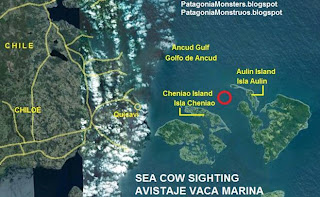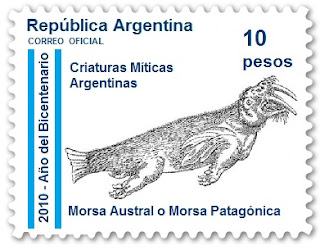Chiloé area where "sea cow" and "water trauco" were sighted".
Copyright © 2010 by Austin Whittall
Copyright © 2010 by Austin Whittall
Continuing with the mysterious Patagonian sea creatures, I will go back to the Patagonian "sea cow" because today I read an interesting post by Alejandra Leighton Naranjo, Anthropologist of the Unidad de Salud Colectiva of Chiloé [1]
She posted the story told to her by an old inhabitant of Mechuque Island, Arsenio Huichaquelen which mentions a "sea cow" and which I quote in full below: (Source: [1]):
The Camahueto and the Sea Cow
[You can read my post on Camahueto, to brush up on this Patagonian unicorn, a bull-like creature with one horn jutting out of its head]
About 60 years ago, Mr. Ramiro Oyarzo, a diving suit diver came across the Camahueto and the Sea Cow while he was diving in the channel between the [Islands of] Cheniao y Aulín. [1]
The channel mentioned by Arsenio is located at approximately 42°15'S and 73°13'W. Aulín Island is part of th Butachauques Islands and Cheniao is part of the Mechuque Islands. Both of these islands are part of the Ancud Gulf, and located between Chiloé Island and the mainland, in Chile. I marked the spot with a red circle in the map above.
Now back to our story:
He barely saved himself because the animals chased him in the deep sea. At that place there is an enclosure where, deep down, the animals lived. Don Ramiro said that that explained why that part of the channel was so bad for sailing.
(The Sea Cow is like a cow, but with fins [1]
The story has both creatures (cow and camahueto) behave like the regular "land" bovines. With an enclosure an all. It also gives them supernatural powers to disturb the waters and imperil navigation.
But lets just imagine that these details are just embellishments that were added to make the story better, and hide the essence of it: the diver came across some weird sea creatures and his mind classed them as sea cow and camahueto.
We can guess that they were not sea wolves or sea lions / seals because the diver would have recognized them. They were surely something else. Maybe a "Southern sea cow" or manatee, or perhaps a walrus? We will never know for sure.
It is interesting to point out that in the same area (see map above), there is another strange being:
The ‘Water Trauco’
Do not mistake it for the minute Trauco, a landlubber evil and perverse dwarf.
This is anothre variety, a sea-run trauco, one that lives in the ocean, quite different to the dwarf.
It lives at Mount Quicaví on the east coast of Chiloé, and is describe as a dangerous male goat. With a long beard and legs similar to those of a guanaco. Its body is covered with fish-like scales and bushy hair. [2] Perhaps some other variety of sea cow.
Bibliography
[1] Relatos de Don Arsenio. Salud Colectiva Chiloé. 01.05.10.
[2] Barrio, J. El Diccionario de Mitos y Leyendas. On line.
Lea este post en español
Patagonian Monsters - Cryptozoology, Myths & legends in Patagonia2010 International Year of Biodiversity Copyright 2009-2010 by Austin Whittall ©
























